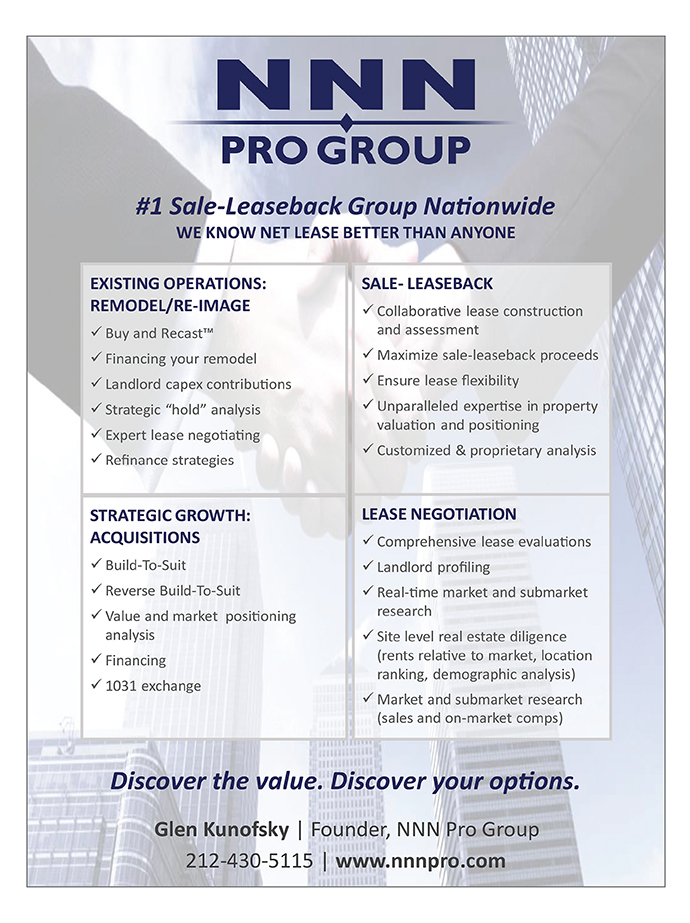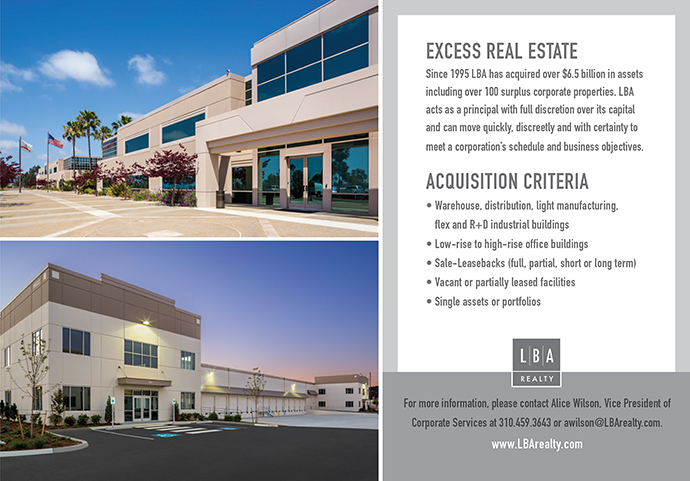Sale-leaseback has long been an effective capital solution for operators, franchisees and franchisors, and private equity groups. Utilized as a financing vehicle, sale-leaseback allows a company flexibility within their capital structure to redeploy capital into its core business, reduce long and short-term debt, make distributions and fund new developments or remodels.
A traditional mortgage requires an operator/real estate owner to keep a material amount of capital in a property. For example, most banks offer loan amounts of 60 to 75 percent of the property value. Sale-leasebacks allow owners to access 100 percent of that property value, ultimately with no balloon payment, by signing a long-term lease. A standard lease in today’s market is typically 10 to 20 years, with base rent subject to increases annually or every five years. The sales proceeds generally are used to pay down debt, fund capex charges and fund new location developments.
Sale-leaseback can be a prevalent piece of the capital structure in an acquisition of a company along with traditional bank debt, mezzanine debt and credit lines. In a sale-leaseback transaction, an owner/operator sells a property to an investor in exchange for a lease commitment by the operator as the tenant. More recently, private equity groups, franchisees, and operators have used sale-leaseback to expand their companies through acquisitions, leveraged buyouts, mergers or roll-ups. Through this strategy, these groups can simultaneously sale-leaseback their new locations along with their acquisition of the business. This provides business operators the ability to take on an acquisition they may not have previously had the capital to secure, and in many cases, the sale-leaseback of the real estate can be for more than their purchase price of the operating business and the underlying real estate.
“The sale-leaseback transactions provided the Company with net proceeds (after tax and transaction related costs) of approximately $164 million, which we expect to use to pay down debt under the company’s credit agreement, repurchase company shares, and for other corporate purposes, while maintaining prudent leverage.”
— Bob Evans Farms CAO and CFO Mark Hood, April 2016, on the $197-million sale-leaseback of 143 restaurants in two transactions with National Retail Properties, Inc. and Mesirow Realty Sale-Leaseback, Inc.
In addition to business acquisitions, sale-leaseback can be a useful tool for opening new locations or renovating existing locations. As with an acquisition, an operator can use sale-leaseback to fund the development of a new location by entering into a contract to purchase a property, and finding a sale-leaseback buyer who will close under the terms of the operator’s purchase contract. This technique can allow operators the ability to fund new development and meet development requirements.
One of the newer, creative forms of sale-leaseback is utilized by operators who do not presently own the real estate of their business, but are subject to an existing lease. Most tenants who are presently under a lease are not aware that they can create that same sale-leaseback model through a Buy and Recast™ strategy. Buy and Recast™ is when a tenant purchases the property back from the existing landlord. Once the purchase agreement is executed, the operator can market the property with the intention of selling to a sale-leaseback investor. The purchase price and new lease terms are combined to determine the current property value and cost of the renovations to recalibrate or “recast” lease terms.
In most cases, the tenant is never taking title to the property, as the current landlord will direct deed the property to the sale-leaseback purchaser. This process is somewhat similar in form to a residential refinance of a home mortgage where the lease payment goes down because the new longer lease is at a lower rate for the tenant based on the longer lease commitment.
Regardless of the strategy that is employed, sale-leaseback can be an extremely useful solution for many groups who are trying to expand, reduce debt, fund capex or monetize their existing real estate.

Glen Kunofsky is an executive managing director of investments with Marcus & Millichap (www.marcusmillichap.com), as well as a senior director of both the National Retail Group and Net Lease Properties Group. Glen joined Marcus & Millichap in 2001, and in 2003 founded the NNN Pro Group, Marcus & Millichap’s premier net lease and sale-leaseback group, of which he is currently president. He has represented purchasers and sellers on over 4,000 properties, totaling more than $6.0 billion in property value, including over $500 million in each of the past 4 years.



